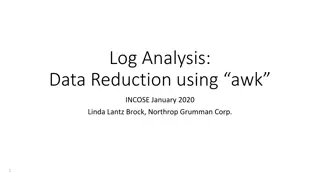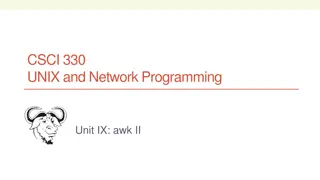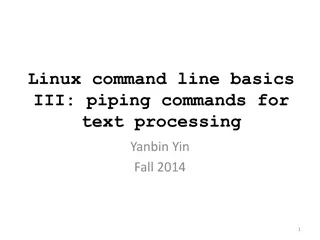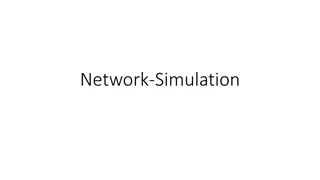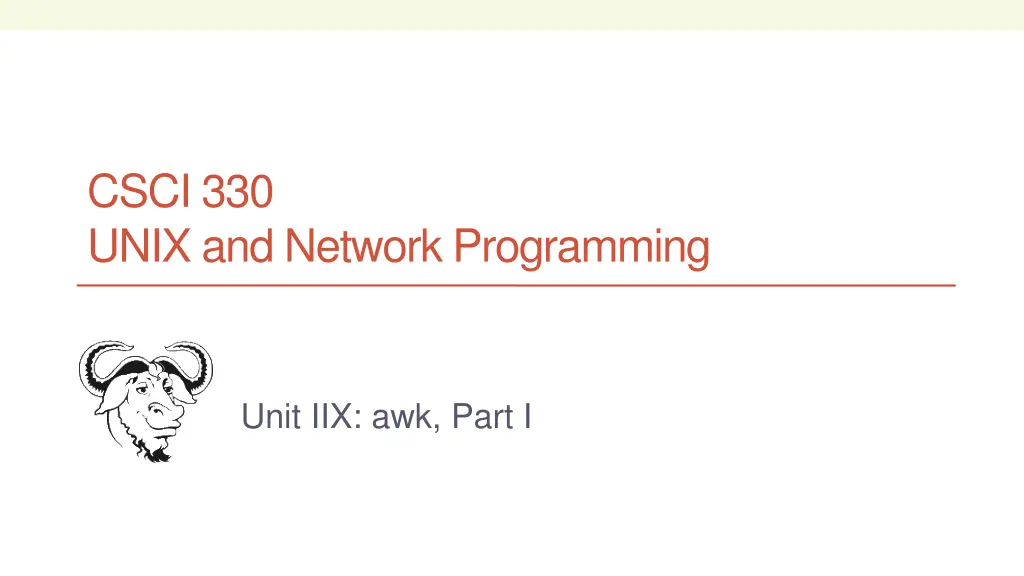
UNIX and Network Programming with awk - CSCI 330 Tutorial
Learn about the powerful awk scripting language used for data manipulation and report generation in UNIX systems. Discover the basics of awk invocation, script patterns, actions, variables, and how to effectively use awk for transforming data files and producing formatted reports.
Download Presentation

Please find below an Image/Link to download the presentation.
The content on the website is provided AS IS for your information and personal use only. It may not be sold, licensed, or shared on other websites without obtaining consent from the author. If you encounter any issues during the download, it is possible that the publisher has removed the file from their server.
You are allowed to download the files provided on this website for personal or commercial use, subject to the condition that they are used lawfully. All files are the property of their respective owners.
The content on the website is provided AS IS for your information and personal use only. It may not be sold, licensed, or shared on other websites without obtaining consent from the author.
E N D
Presentation Transcript
CSCI 330 UNIX and Network Programming Unit IIX: awk, Part I
CSCI 330 - The UNIX System 2 What is awk? created by: Aho, Weinberger and Kernighan scripting language used for manipulating data and generating reports versions of awk: awk, nawk, mawk, pgawk, GNU awk: gawk
CSCI 330 - The UNIX System 3 What can you do with awk? awk operation: reads a file line by line splits each input line into fields compares input line/fields to pattern performs action(s) on matched lines Useful for: transform data files produce formatted reports Programming constructs: format output lines arithmetic and string operations conditionals and loops
CSCI 330 - The UNIX System 4 Basic awk invocation awk 'script' file(s) awk f scriptfile file(s) common option: -F to change field separator
CSCI 330 - The UNIX System 5 Basic awk script consists of patterns & actions: pattern {action} if pattern is missing, action is applied to all lines if action is missing, the matched line is printed must have either pattern or action Example: awk '/for/ { print }' testfile prints all lines containing string for in testfile
CSCI 330 - The UNIX System 6 awk variables awk reads input line into buffers: record and fields field buffer: one for each field in the current record variable names: $1, $2, record buffer: $0 holds the entire record
CSCI 330 - The UNIX System 7 More awk variables NR NF Number of the current record Number of fields in current record also: FS Field separator (default=whitespace)
CSCI 330 - The UNIX System 8 Example: Records and Fields % cat emps Tom Jones 4424 5/12/66 543354 Mary Adams 5346 11/4/63 28765 Sally Chang 1654 7/22/54 650000 Billy Black 1683 9/23/44 336500 % awk '/Tom/ { print }' emps Tom Jones 4424 5/12/66 543354
CSCI 330 - The UNIX System 9 Example: Records and Fields % cat emps Tom Jones 4424 5/12/66 543354 Mary Adams 5346 11/4/63 28765 Sally Chang 1654 7/22/54 650000 Billy Black 1683 9/23/44 336500 % awk '{print NR, $0}' emps 1 Tom Jones 4424 5/12/66 543354 2 Mary Adams 5346 11/4/63 28765 3 Sally Chang 1654 7/22/54 650000 4 Billy Black 1683 9/23/44 336500
CSCI 330 - The UNIX System 10 Example: Space as Field Separator % cat emps Tom Jones 4424 5/12/66 543354 Mary Adams 5346 11/4/63 28765 Sally Chang 1654 7/22/54 650000 Billy Black 1683 9/23/44 336500 % awk '{print NR, $1, $2, $5}' emps 1 Tom Jones 543354 2 Mary Adams 28765 3 Sally Chang 650000 4 Billy Black 336500
CSCI 330 - The UNIX System 11 Example: Colon as Field Separator % cat emps2 Tom Jones:4424:5/12/66:543354 Mary Adams:5346:11/4/63:28765 Sally Chang:1654:7/22/54:650000 Billy Black:1683:9/23/44:336500 % awk -F: '/Jones/{print $1, $2}' emps2 Tom Jones 4424
CSCI 330 - The UNIX System 12 Special Patterns BEGIN matches before the first line of input used to create header for report END matches after the last line of input used to create footer for report
CSCI 330 - The UNIX System 13 example input file Jan 13 25 15 115 Feb 15 32 24 22 Mar 15 24 34 228 Apr 31 52 63 420 May 16 34 29 208 Jun 31 42 75 492 Jul 24 34 67 436 Aug 15 34 47 316 Sep 13 55 37 277 Oct 29 54 68 525 Nov 20 87 82 577 Dec 17 35 61 401 Jan 21 36 64 620 Feb 26 58 80 652 Mar 24 75 70 495 Apr 21 70 74 514
CSCI 330 - The UNIX System 14 awk example runs awk '{print $1}' input awk '$1 ~ /Feb/ {print $1}' input awk '{print $1, $2+$3+$4, $5}' input awk 'NF == 5 {print $1, $2+$3+$4, $5}' input
CSCI 330 - The UNIX System 15 awk example script BEGIN { print "January Sales Revenue" } $1 ~ /Jan/ { print $1, $2+$3+$4, $5 } END { print NR, " records processed" }
CSCI 330 UNIX and Network Programming 16 Categories of Patterns simple patterns BEGIN, END expression patterns: whole line vs. explicit field match whole line field match range patterns specified as from and to: example: /regExp/ $2 ~ /regExp /regExp/,/regExp/
CSCI 330 UNIX and Network Programming 17 awk actions basic expressions output: decisions: if loops: print, printf for, while
CSCI 330 UNIX and Network Programming 18 awk Expression consists of: operands and operators operands: numeric and string constants variables functions and regular expression operators: assignment: = ++ -- += -= *= /= arithmetic: + - * / % ^ logical: && || ! relational: > < >= <= == != match: ~ !~ string concatenation: space
CSCI 330 UNIX and Network Programming 19 awk Variables created via assignment: var = expression types: number (not limited to integer) string, array variables come into existence when first used type of variable depends on its use variables are initialized to either 0 or
CSCI 330 UNIX and Network Programming 20 awk variables example BEGIN { print "January Sales Revenue" count = 0 sum = 0 } $1 ~ /Jan/ && NF == 5 { print $1, $2+$3+$4, $5 count++ sum += $5 } END { print count, " records produce: ", sum }
CSCI 330 UNIX and Network Programming 21 awk output: print Writes to standard output Output is terminated by newline If called with no parameter, it will print $0 Printed parameters are separated by blank Print control characters are allowed: \n \f \a \t \b \\
CSCI 330 UNIX and Network Programming 22 print examples % awk '{print $1, $2}' grades john 85 andrea 89 jasper 84 % awk '{print $1 "," $2}' grades john,85 andrea,89 jasper,84
CSCI 330 UNIX and Network Programming 23 printf: Formatting output Syntax: printf(format-string, var1, var2, ) each format specifier within format-string requires additional argument of matching type %d, %i decimal integer %c single character %s string of characters %f floating point number
CSCI 330 UNIX and Network Programming 24 Format specifier modifiers between % and letter %10s %7d %10.4f %-20s meaning: width of field, field is printed right justified ( - will left justify) precision: number of digits after decimal point
CSCI 330 UNIX and Network Programming 25 awk Example: list of products 101:propeller:104.99 102:trailer hitch:97.95 103:sway bar:49.99 104:fishing line:0.99 105:mirror:4.99 106:cup holder:2.49 107:cooler:14.89 108:wheel:49.99 109:transom:199.00 110:pulley:9.88 111:lock:31.00 112:boat cover:120.00 113:premium fish bait:1.00
CSCI 330 UNIX and Network Programming 26 awk Example: output Marine Parts R Us Main catalog Part-id name price ====================================== 101 propeller 104.99 102 trailer hitch 97.95 103 sway bar 49.99 104 fishing line 0.99 105 mirror 4.99 106 cup holder 2.49 107 cooler 14.89 108 wheel 49.99 109 transom 199.00 110 pulley 9.88 111 lock 31.00 112 boat cover 120.00 113 premium fish bait 1.00 ====================================== Catalog has 13 parts
CSCI 330 UNIX and Network Programming 27 awk Example: complete BEGIN { FS= ":" print "Marine Parts R Us" print "Main catalog" print "Part-id\tname\t\t\t price" print "==================================" } { printf("%3d\t%-20s\t%6.2f\n", $1, $2, $3) } END { print "==================================" print "Catalog has", NR, "parts" }
CSCI 330 UNIX and Network Programming 28 Summary next: more awk arrays control structures

